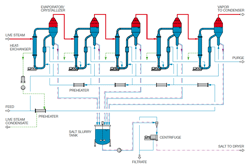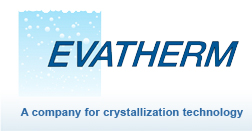If raw brine as feed and low pressure steam for heating is available, the Multi-Stage Vacuum system is preferred. Purity levels can be set by the application of the adequate elutriation and purge systems.
The Multiple Effect Evaporation plant is maybe the most classical process for the production of salts. The principle is quite simple. The first effect is heated by live-steam; the following stages are heated by the vapors of the upstream unit. With the number of effects the live steam consumption can be reduced accordingly. The applied number of effects is varying between 2 and 6, maybe 7.
The number of effects can not be increased arbitrarily as the maximal available temperature range is given. On the low-temperature end (the last effect) the ambient conditions such as cooling water or air temperature are limiting factors, on the high-temperature end the mechanical design and the corrosion resistance of the selected materials determines the upper limit. The available steam pressure can determine the operation pressure of the first effect as well (normally low pressure steam of 4-6 barg is enough to run a 5 or 6 effect plant). It has also to be considered, that high number of effects means also an enlarged overall heating surface, which is an important cost factor.
Achieving an optimal design means to find the optimum between energy -and investment costs. Beside of the correct number of effects the preheating concept plays the most decisive role. Sophisticated preheating systems make the difference between standard and “high-end” installations.
In order to ensure optimal plant efficiency in terms of primary energy consumption, the steam should be generated at higher pressure in order to utilize the exergy for power generation by a counter pressure steam turbine or better a gas or steam turbine cogeneration unit. The back pressure steam can be used to heat the evaporation plant. At a smaller evaporation capacity, where the utilization of a cogeneration system is not possible or feasible, the overall efficiency can be improved by thermal vapor recompression (ejector).



